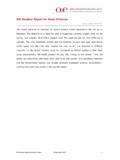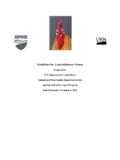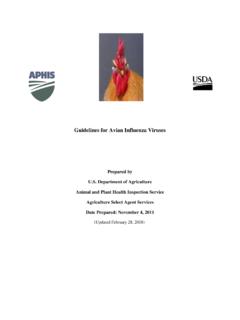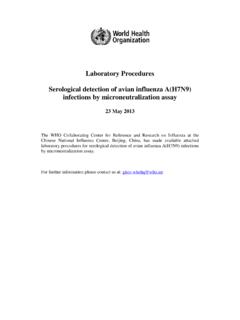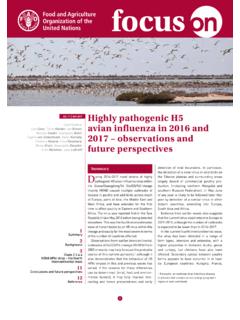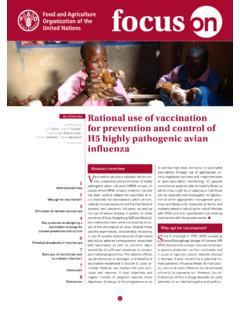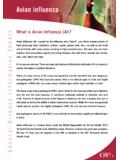Transcription of Avoiding the risk of infection when working with …
1 1 Avoiding the risk of infection when working with poultry that is suspected of having H5 or H7 notifiable avian influenza Contents: Routes of 2 Be vigilant .. 2 Action to take if you suspect disease:.. 2 Avoiding risks to your 2 Put on and remove PPE in the correct order .. 3 Actions when H5 or H7 avian influenza infection in poultry is 4 4 Vaccination and use of anti-virals .. 4 Risks to others .. 4 This guidance applies to all persons working commercially with poultry including the self-employed. Veterinary surgeons and other people working with poultry and birds will also wish to take this guidance into account when undertaking their own risk assessments of safe working practices. This guidance note has been produced by a Government & Industry working Group consisting of representatives from the National Farmers Union (NFU), British Egg Industry Council (BEIC), British Poultry Council (BPC), Health and Safety Executive (HSE), Health Protection Agency (HPA), Department of Health (DH), Department for Environment, Food and Rural Affairs (Defra) and Animal Health (AH) (formerly the State Veterinary Service (SVS)).
2 2 Good occupational hygiene precautions that should routinely be used when working with poultry to avoid other zoonotic diseases will also control the risk of exposure to H5 or H7 notifiable avian influenza . Routes of infection H5 and H7 avian influenza infections are not normally present on UK poultry farms. However occasional outbreaks do occur but are subject to compulsory disease control measures to ensure they are eradicated. If avian influenza transmission to poultry workers were to occur, it would be by direct contact with sick and dead or dying infected birds or infected bird products (principally droppings and respiratory secretions). As the virus can live on for a while in the environment it is likely that infection can spread from surfaces, dust, etc freshly contaminated with such bird products. The severity of any illness that might arise will vary according to the exact type of avian influenza present.
3 Be vigilant Look out for signs of disease in your flock. Indicators may include increased mortality, falling egg production and respiratory distress. Action to take if you suspect disease: a) ask your vet for advice immediately and if you suspect avian influenza you must inform Animal Health without delay; b) minimise the number of people potentially exposed to the virus where possible keep people away from the potentially infected poultry; c) do not move poultry, poultry products, manure/litter or other livestock from the premises; If infection with avian influenza is suspected an Animal Health vet will visit the farm and, as well as inspecting the birds, will advise you what other measures need to be taken. If a notifiable disease such as avian influenza is suspected, the premises will be placed under restriction and samples will be taken for analysis; Avoiding risks to your health Wear the correct PPE.
4 If you have to enter the environment in which the poultry with possible avian influenza are kept or you are in close contact with potentially infected birds or bird products, then the same standard of Personal Protective Equipment (PPE) must be worn as would be the case if the presence of H5 or H7 avian influenza had been confirmed; PPE should be worn at all times when working in a potentially infected environment. Typically, this will comprise: disposable or polycotton coverall with head coverage of CE type 5 & 6 that offer protection against dusts, splashes and liquid sprays ( with , as appropriate, safe disposal or cleaning after use); disposable gloves of lightweight nitrile or vinyl or heavy duty rubber (not latex) gloves that can be disinfected; rubber or polyurethane boots that can be cleaned and disinfected; FFP3 respirator with exhalation valve close fitting goggles or other equipment that gives at least the same level of protection.
5 All PPE should be suitable for the wearer and, where appropriate, should be fit-tested to the person. 3 Coverall, gloves, waterproof footwear and face-fitted respiratory protective equipment and goggles. Waterproof and washable footwear Choose the most appropriate glove for the task. Hand hygiene measures (hand washing) should be performed after removal of PPE. Put on and remove PPE in the correct order You should be trained in proper techniques of donning, removing and disposing of PPE, without contaminating yourself. The following is a summary of the recommended order of removal of protective equipment: 1. Wash and disinfect boots 2. Remove hood of overall 3. Remove gloves 4. Remove coverall 5. Remove boots 6. Wash/decontaminate hands 7. Remove eye protection 48. Remove mask/respirator 9. Wash/decontaminate hands again Dispose of all PPE safely Actions when notifiable avian influenza infection in poultry is confirmed If notifiable avian influenza infection in poultry is confirmed, the Government will arrange for the poultry on that farm and any direct contact birds to be humanely killed and transported to specialist incineration or rendering facilities for disposal.
6 Any eggs on the premises may also need to be removed for disposal. The buildings and equipment will then be sprayed with disinfectant and the poultry keeper will then arrange for the premises to be thoroughly cleansed and disinfected under the supervision of an Animal Health vet. First-aid Immediately wash all cuts and grazes and cover with waterproof dressings. Vaccination and use of anti-virals There is currently no vaccine licensed to protect poultry workers against any strain of avian influenza . when an outbreak of notifiable avian influenza is confirmed, poultry workers on the infected farm together with vets, contractors and other people engaged in disease control activities will be offered antiviral therapy Oseltamivir (Tamiflu ) or zanamivir (Relenza ). Seasonal influenza vaccine may also be offered but ideally this should have been given early on in the influenza season as part of the national programme so that effective levels of antibodies are present.
7 Seasonal influenza vaccine will not protect against avian influenza , but is offered to guard against the possibility of simultaneous infection with seasonal flu, and will reduce the risk of mixing and re-assortment of the avian influenza virus., there is a risk that if a person becomes infected with both avian influenza and human flu that a re-assortment of the genetic material of the viruses may result in a new strain that can be transmitted directly from human to human potentially leading to a flu pandemic. Antiviral drugs and seasonal influenza vaccine will be made available and administered through the Health Protection Agency s (HPA) local Health Protection Units in collaboration with the NHS. Risks to others If this guidance is followed, the risks of infection of friends and family members who are not exposed to infected poultry are believed to be negligible. Furthermore, all people potentially exposed to the avian influenza virus on an infected farm will be traced and their health status will be checked and monitored.
8










